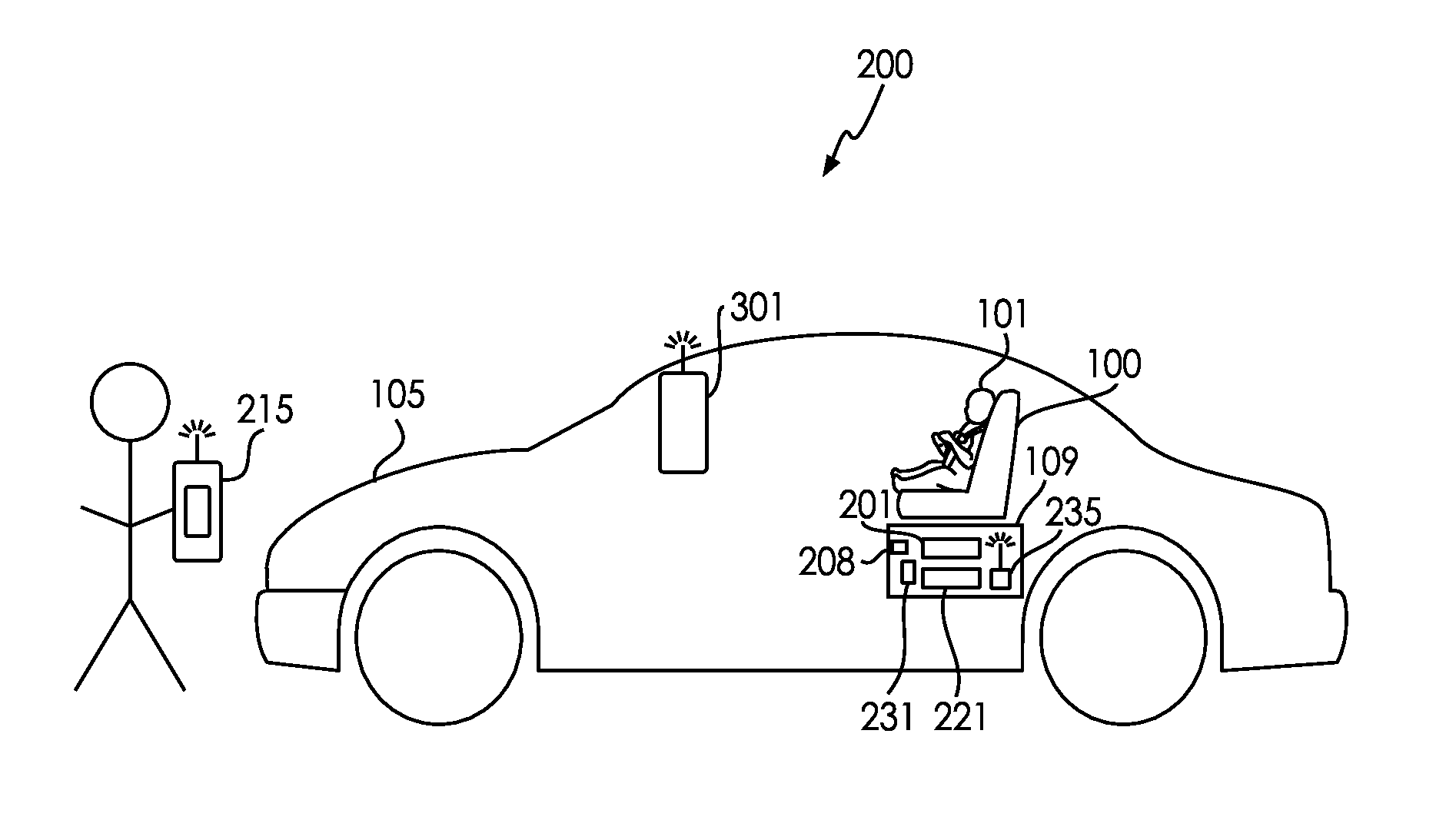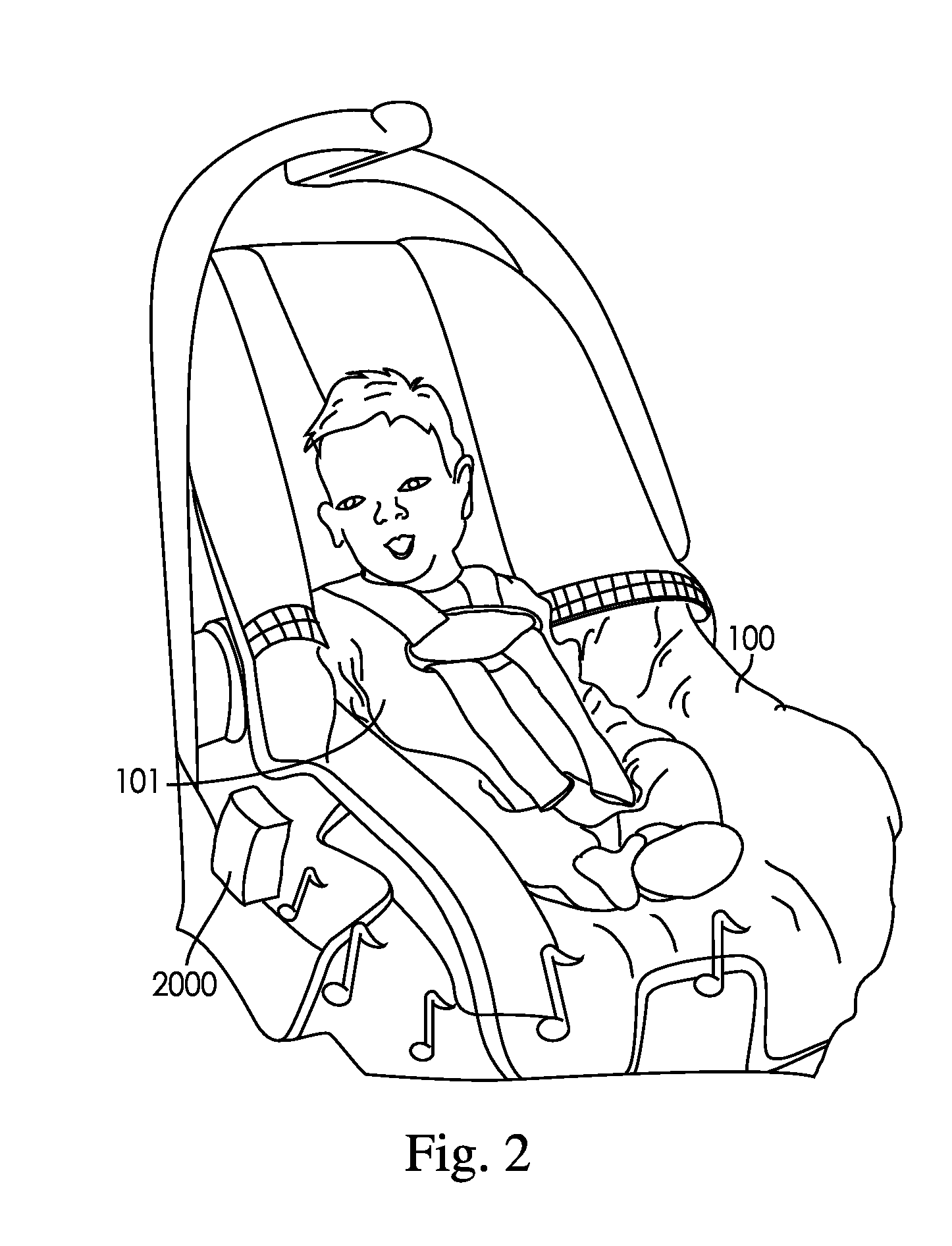Systems and Methods for Indicating the Presence of a Child in a Vehicle
a technology for indicating the presence of a child in a vehicle and a vehicle body, applied in the direction of child seats, pedestrian/occupant safety arrangements, instruments, etc., can solve the problems of significant hand-wringing over the possibility of a parent being so forgetful, the thought of it being accidental is simply unbelievable, and the family is devastated. , to achieve the effect of enabling or disabling airbags
- Summary
- Abstract
- Description
- Claims
- Application Information
AI Technical Summary
Benefits of technology
Problems solved by technology
Method used
Image
Examples
example 1
Logic for Determining if the Vehicle (105) is Moving or Not Moving
[0139]If the motion sensor (221), an accelerometer for this case, output changes by more than 0.1 g or 60 millivolts in any 200 millisecond period and outputs acceleration in the same direction for each of the 67 millisecond periods During this 200 millisecond period. It can be determined that the vehicle (105) is moving
[0140]If these two conditions are met we assume the vehicle (105) is moving and Timer 1 (120 second timer) is reset to zero seconds. If timer 1 reaches 120 seconds the vehicle (105) is determined not to be moving, and the motion Sensor and vehicle (105) seat sensor are activated and monitored. At this point it is assumed that the vehicle (105) is still and possibly turned off with a child unattended in the vehicle (105).
[0141]The software that monitors the accelerometer output is constantly looking for these cases to establish if the vehicle (105) is sitting still, a child is moving in the seat or if a...
example 2
Logic for Motion Detector 2 to Sound Alarm
[0143]If no vehicle (105) motion that is consistent with a properly started, running or rolling vehicle (105) is detected from the vehicle (105) motion sensors (1) for 120 seconds the Motion detector (2) is enabled to detect the presence of an intruder or child in the vehicle (105)
[0144]When the Microprocessor senses a change in the output of Motion sensor 2, it enables and starts another 120-second timer that counts the number of Motion detector 2 changes that occur in the next 120 seconds. If the microprocessor senses 2 (2 being an arbitrary number to avoid false alarms) or more changes within this 120-second timer window or if the initial pulse is continuously low for 120 seconds an alarm signal is transmitted to activate any combination of systems or devices mentioned in section 1, If one (one being an arbitrary number) pulse less than 120 seconds in duration is detected nothing happens.
example 3
Logic for Vehicle (105) Seat Detector to Sound Alarm
[0145]If the child detector circuit (201) detects the presence of a child (101) its output state changes. When the controller (231) senses this change it starts a 120 second timer that counts the number of changes that occur within 120 seconds. If the controller (231) senses more than two changes within this 120-second timer window or if the change of state is continuous for 120 seconds an alarm signal is transmitted to any combination of the systems and devices mentioned in section 1
[0146]120 seconds was chosen to allow time to Open the vehicle (105) door, secure the child and any belongings into the vehicle (105) (Approximately 100 seconds) Close doors and Start vehicle (105) Approximately 20 seconds. 120 seconds was chosen to allow additional time on top of the 120 seconds to remove the child from the vehicle (105) seat.
[0147]If a child were left in an unattended vehicle (105) that does not have the ignition on, the alarm would ...
PUM
 Login to View More
Login to View More Abstract
Description
Claims
Application Information
 Login to View More
Login to View More - R&D
- Intellectual Property
- Life Sciences
- Materials
- Tech Scout
- Unparalleled Data Quality
- Higher Quality Content
- 60% Fewer Hallucinations
Browse by: Latest US Patents, China's latest patents, Technical Efficacy Thesaurus, Application Domain, Technology Topic, Popular Technical Reports.
© 2025 PatSnap. All rights reserved.Legal|Privacy policy|Modern Slavery Act Transparency Statement|Sitemap|About US| Contact US: help@patsnap.com



